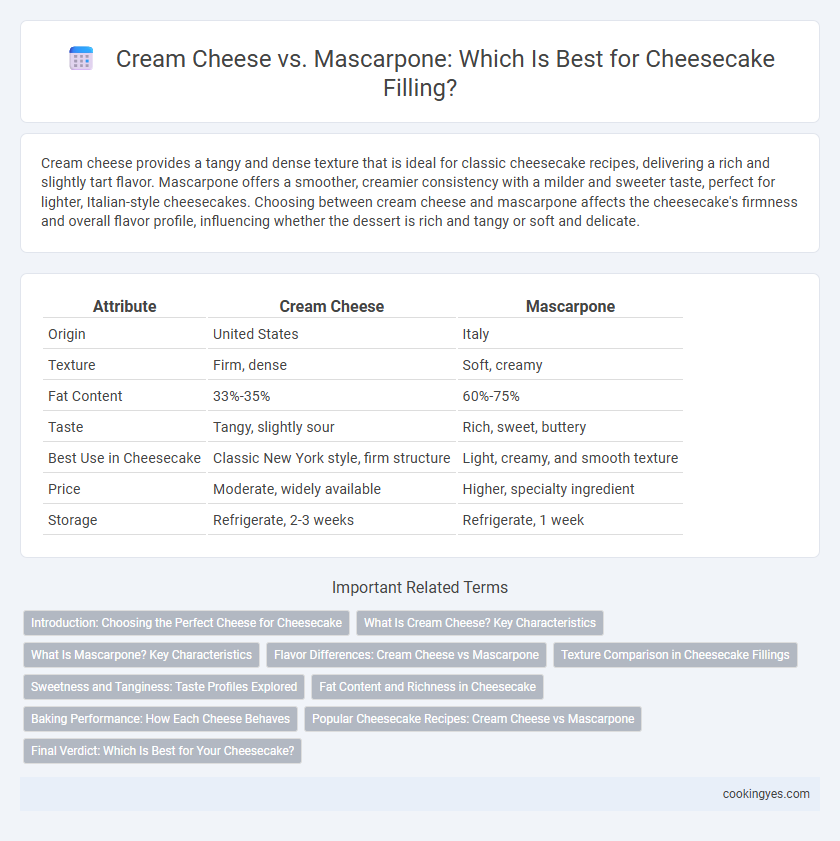Cream cheese provides a tangy and dense texture that is ideal for classic cheesecake recipes, delivering a rich and slightly tart flavor. Mascarpone offers a smoother, creamier consistency with a milder and sweeter taste, perfect for lighter, Italian-style cheesecakes. Choosing between cream cheese and mascarpone affects the cheesecake's firmness and overall flavor profile, influencing whether the dessert is rich and tangy or soft and delicate.
Table of Comparison
| Attribute | Cream Cheese | Mascarpone |
|---|---|---|
| Origin | United States | Italy |
| Texture | Firm, dense | Soft, creamy |
| Fat Content | 33%-35% | 60%-75% |
| Taste | Tangy, slightly sour | Rich, sweet, buttery |
| Best Use in Cheesecake | Classic New York style, firm structure | Light, creamy, and smooth texture |
| Price | Moderate, widely available | Higher, specialty ingredient |
| Storage | Refrigerate, 2-3 weeks | Refrigerate, 1 week |
Introduction: Choosing the Perfect Cheese for Cheesecake
Cream cheese offers a tangy flavor and dense texture that creates the classic rich and creamy cheesecake experience. Mascarpone provides a smoother, milder taste with higher fat content, resulting in a silkier and more delicate filling. The choice between cream cheese and mascarpone impacts the cheesecake's overall flavor profile, texture, and richness, making it essential to select based on desired indulgence and recipe style.
What Is Cream Cheese? Key Characteristics
Cream cheese is a soft, mild-tasting fresh cheese made from a blend of cream and milk, commonly used as a primary ingredient in cheesecake filling due to its smooth texture and tangy flavor. Its key characteristics include a creamy consistency, slightly acidic taste, and high fat content that contributes to the rich, dense structure of traditional New York-style cheesecakes. Unlike mascarpone, cream cheese provides a firmer set and a distinctive tang that balances sweetness in the filling.
What Is Mascarpone? Key Characteristics
Mascarpone is a soft Italian cream cheese made from whole cream, known for its rich, velvety texture and mildly sweet flavor, distinguishing it from the tangier cream cheese. It contains a higher fat content, typically around 60-75%, which contributes to its smooth consistency and luxurious mouthfeel in cheesecake fillings. This cheese lacks the acidic tang of cream cheese due to its production process, which uses citric or tartaric acid instead of bacterial cultures, making mascarpone ideal for creamy, less tart cheesecakes.
Flavor Differences: Cream Cheese vs Mascarpone
Cream cheese offers a tangy and slightly sharp flavor that provides a classic, richer taste to cheesecake fillings, making it the traditional choice for many recipes. Mascarpone is smoother and milder with a subtle sweetness and creamy texture, creating a more delicate and velvety dessert experience. Choosing between cream cheese and mascarpone significantly impacts the cheesecake's flavor profile, texture, and richness.
Texture Comparison in Cheesecake Fillings
Cream cheese offers a dense, tangy texture that provides structure and a slight firmness to cheesecake fillings, making it ideal for traditional-style cheesecakes. Mascarpone delivers a richer, smoother, and creamier texture with less tang, resulting in a silkier and more delicate mouthfeel in the final dessert. Combining both can balance firmness and creaminess, enhancing the cheesecake's overall luscious texture.
Sweetness and Tanginess: Taste Profiles Explored
Cream cheese offers a balanced tanginess and moderate sweetness, providing a classic rich and slightly tart flavor essential for traditional cheesecake fillings. Mascarpone contributes a milder tang with a creamier, sweeter profile, making it ideal for lighter, less tangy desserts. Choosing between cream cheese and mascarpone depends on the desired sweetness and tanginess level in the cheesecake's overall taste profile.
Fat Content and Richness in Cheesecake
Cream cheese typically contains around 33-35% fat, providing a tangy flavor and dense texture that forms the classic cheesecake base. Mascarpone, with its higher fat content of approximately 40-45%, offers a richer, creamier consistency that yields a smoother and more decadent filling. Choosing between cream cheese and mascarpone impacts the cheesecake's richness, with mascarpone delivering a luxuriously velvety mouthfeel compared to the firmer, slightly tangier cream cheese.
Baking Performance: How Each Cheese Behaves
Cream cheese offers a dense and tangy texture that firms up well during baking, providing a classic cheesecake structure with a slight chewiness. Mascarpone is richer and creamier, melting smoothly into the batter for a silkier, softer consistency but may result in a more delicate set that can be slightly less stable when sliced. Understanding the moisture content and fat percentage differences is key, as cream cheese has lower fat and firmer texture while mascarpone's higher fat content creates creamier, less dense fillings ideal for no-bake or lightly baked cheesecakes.
Popular Cheesecake Recipes: Cream Cheese vs Mascarpone
Popular cheesecake recipes typically rely on cream cheese for its tangy flavor and dense texture, which creates a classic, firm filling. Mascarpone offers a richer, creamier consistency with a milder taste, resulting in a softer, silkier cheesecake often favored in Italian-style desserts. Both cheeses influence the final cheesecake's mouthfeel and flavor profile, with cream cheese delivering a more pronounced tang and mascarpone providing a delicate, buttery smoothness.
Final Verdict: Which Is Best for Your Cheesecake?
Cream cheese provides a tangy, dense texture that holds traditional cheesecake shapes well, making it ideal for classic New York-style cheesecakes. Mascarpone offers a richer, creamier profile with a subtle sweetness, enhancing lighter, mousse-like cheesecakes or Italian-inspired desserts. Choosing between them depends on the desired flavor intensity and texture, with cream cheese favored for a firm, tangy finish and mascarpone preferred for a smooth, buttery richness.
Cream Cheese vs Mascarpone for Cheesecake Filling Infographic

 cookingyes.com
cookingyes.com